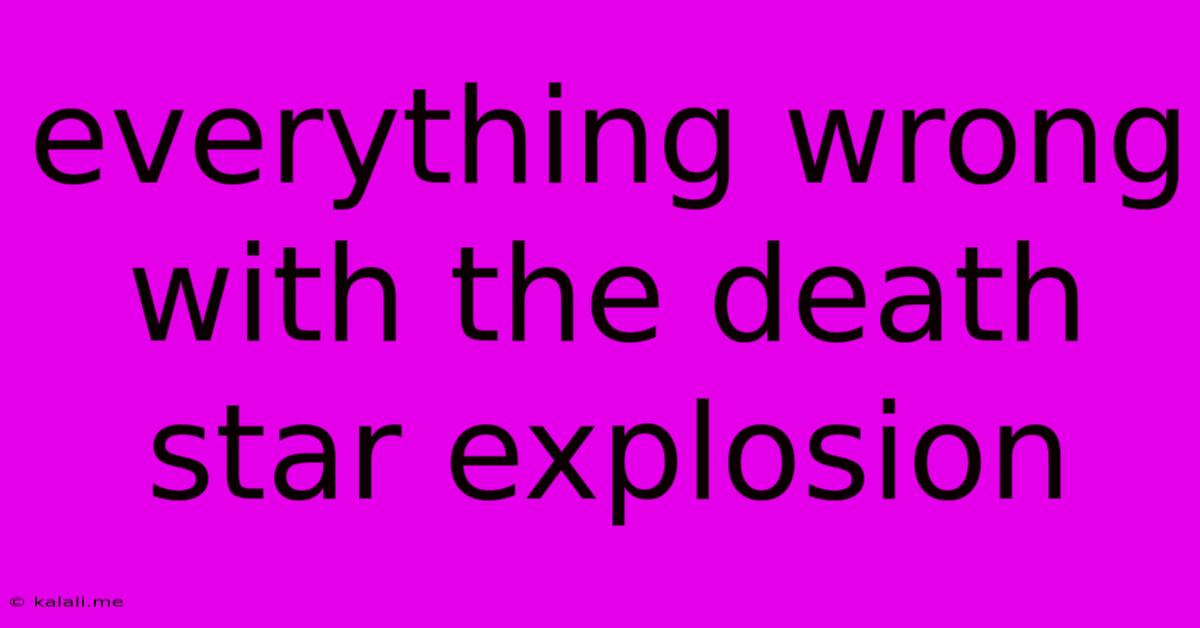Everything Wrong With The Death Star Explosion
Kalali
Jun 05, 2025 · 3 min read

Table of Contents
Everything Wrong with the Death Star Explosion: A Physics-Based Critique
The Death Star's destruction in Star Wars: A New Hope is an iconic cinematic moment. But let's be honest, the physics behind it are… questionable. This article dives into the inconsistencies and impossibilities surrounding the explosion, exploring why it simply wouldn't happen the way it's depicted. This isn't about nitpicking; it's about appreciating the artistry while acknowledging the scientific liberties taken.
The Immense Energy Required: The Death Star, a moon-sized battle station, possesses immense mass. Completely obliterating it requires an unimaginable amount of energy – far beyond what a single proton torpedo could realistically provide. Even a near-complete destruction, as seen in the film, demands an energy release exceeding the most powerful nuclear weapons ever conceived. The scale of the explosion defies the energy output observed from the torpedoes. The visual spectacle is breathtaking, but the physics are wildly inaccurate.
Internal Structure and Failure:
- Chain Reaction Fallacy: The film depicts a chain reaction: one explosion leading to another, rapidly dismantling the entire station. While chain reactions exist in certain contexts (like nuclear fission), the Death Star's material composition likely wouldn't allow for such a rapid, complete cascading failure. A more realistic scenario would involve localized damage, not instantaneous disintegration.
- Lack of Structural Integrity Considerations: A structure of that size and complexity should have significant redundancy in its design. The explosion should have been far more localized and less "hollywood-esque." The destruction depicted necessitates a complete absence of structural integrity, ignoring the engineering principles necessary to build such a colossal weapon.
- Debris Distribution: The debris field depicted is far too uniform and lacks the chaotic distribution expected from such a massive explosion. The scattering of wreckage should be far more erratic, with varying sizes and velocities, rather than the relatively even distribution we see.
Energy Release and Propagation:
- Proton Torpedo Limitations: The visual representation of the proton torpedo's impact is far too dramatic considering its likely energy output. Even assuming a significantly enhanced energy yield, the explosion should have been far more contained and less visually spectacular. The blast radius should have been considerably smaller.
- Energy Transfer and Dispersion: The rapid, complete vaporization of the Death Star implies almost instantaneous energy transfer throughout its entire mass. In reality, energy transfer and dispersion would be significantly slower and more localized, leading to a less dramatic and less visually complete destruction.
- Shockwave Absence: The lack of a significant shockwave is also noteworthy. Such a massive explosion should generate a powerful shockwave that would have devastating effects on nearby celestial bodies. Its absence further highlights the cinematic liberties taken in the depiction.
The Cinematic Choice vs. Scientific Accuracy:
Ultimately, the Death Star's explosion is a testament to the power of cinematic storytelling. The spectacle is awe-inspiring, and the visual impact is crucial to the narrative. However, from a scientific perspective, the depiction is deeply flawed. The incredible energy requirements, the unrealistic chain reaction, and the flawed energy transfer and propagation significantly deviate from the laws of physics.
The film prioritizes dramatic impact over scientific accuracy, and that’s perfectly acceptable – and even expected – within the realm of science fiction. But understanding the scientific inconsistencies helps us appreciate the artistic license taken to create such a memorable cinematic moment. It also helps us understand why certain cinematic depictions are more fantasy than science.
Latest Posts
Latest Posts
-
Can Muslims Have Sex During Ramadan
Jun 06, 2025
-
Do You Speak Chinese In Chinese
Jun 06, 2025
-
Can I Put Vanilla Extract In My Coffee
Jun 06, 2025
-
Hoses Are Used When Movement Occurs Between Two Parts
Jun 06, 2025
-
How To Dry Clothes Without A Dryer
Jun 06, 2025
Related Post
Thank you for visiting our website which covers about Everything Wrong With The Death Star Explosion . We hope the information provided has been useful to you. Feel free to contact us if you have any questions or need further assistance. See you next time and don't miss to bookmark.